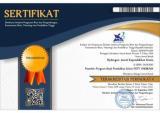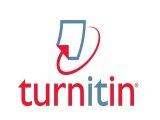Development of Android-Based Chemistry Virtual Laboratory Media on Acid-Base Materials for 11th Grade High School Students
Abstract
This study aimed to develop an Android-based virtual laboratory media for chemistry, assess its validity, and determine students' responses to it. The research methodology employed was research and development (R&D) with the 4D development model (Four D Models) according to Thiagarajan, which comprises four stages: define, design, develop, and disseminate. The study was carried out until the development stage. The research instruments used included interview guides, validation sheets, and questionnaires. The media products developed were validated by material and media expert validators consisting of two chemistry lecturers and one chemistry teacher. Limited trials were conducted with a total of 32 11th grade students from Mathematics and Science (MIPA) 3 class at State Islamic Senior High School (MAN) Blitar City. Data analysis techniques involved both qualitative and quantitative methods. The results indicate that the validation scores from the material and media experts were very valid, with an average percentage score of 98% and 95%, respectively. The student's responses to the limited trials were also very good, with an average percentage score of 88%. Overall, the study demonstrated the potential of the developed Android-based virtual laboratory media for chemistry education.
Keywords
Full Text:
PDFReferences
Ainsworth, S. (2006). DeFT: A Conceptual Framework for Considering Learning with Multiple Representations. Learning and Instruction, 16(3), 183–198. https://doi.org/10.1016/j.learninstruc.2006.03.001
Ardhana, I. A. (2020). Dampak Process-Oriented Guided-Inquiry Learning (POGIL) terhadap Pengetahuan Metakognitif Siswa pada Topik Asam-Basa. Hydrogen: Jurnal Kependidikan Kimia, 8(1), 1. https://doi.org/10.33394/hjkk.v8i1.2545
Asyhar, R. (2011). Kreatif Mengembangkan Media Pembelajaran. Gaung Persada Press.
Bruck, L. B., Bretz, S. L., & Towns, M. H. (2008). Characterizing the Level of Inquiry in the Undergraduate Laboratory. Journal of College Science Teaching, 38(1), 52–58.
Buchori, M. L., Suryadharma, I. B., & Fajaroh, F. (2013). Identifikasi Tingkat Jenis dan Faktor-Faktor Penyebab Kesulitan Siswa MA negeri Wlingi Dalam Memahami Indikator dan pH Larutan Asam Basa. Jurnal Online Universitas Negeri Malang, 2(2), 1–11.
Calimag, N., Miguel, P. A., Conde, R., & B.Aquino, L. (2014). Ubiquitous Learning Environment Using Android Mobile Application. International Journal of Research in Engineering & Technology, 2(2), 119–128.
Chuang, T. Y. and, & Chen, W. F. (2007). Effect of Digital Games on Children’s Cognitive Achievement. Journal of Multimedia, 2(5), 27–30.
Dobrzański, L. A., & Honysz, R. (2011). Virtual Examinations of Alloying Elements Influence on Alloy Structural Steels Mechanical Properties. Journal of Achievements in Materials and Manufacturing Engineering, 49(2), 251–258.
Elisa, E., Wiratmaja, I. G., Nugraha, I. N. P., & Dantes, K. R. (2020). Pengembangan Laboratorium Virtual Kimia Teknik untuk Meningkatkan Keterampilan Berpikir Kritis dan Proses Sains Mahasiswa. Journal of The Indonesian Society of Integrated Chemistry, 12(2), 55–61. https://doi.org/https://doi.org/ 10.22437/jisic.v12i2.11243
Ischak, N. I., Odja, E. A., La Kilo, J., & La Kilo, A. (2020). Pengaruh Keterampilan Proses Sains Melalui Model Inkuiri Terbimbing terhadap Hasil Belajar Siswa pada Materi Larutan Asam Basa. Hydrogen: Jurnal Kependidikan Kimia, 8(2), 58. https://doi.org/10.33394/hjkk.v8i2.2748
Khairani, A. (2021). Desain dan Uji Coba Media Video Pembelajaran Kimia Menggunakan Adobe After Effect Berorientasi Pada Materi Asam Basa. UIN Sultan Syarif Kasim Riau.
Kurbanoglu, N. I., & Akim, A. (2010). The Relationships between University Students’ organic chemistry anxiety, chemistry attitudes, and self-eficacy: A structural equation model. Australian Journal of Teacher Education, 35(8), 48–59. https://doi.org/10.33225/jbse/12.11.347
Lutfi, A. (2017). Pengembangan Media Laboratorium Virtual Bersarana Komputer untuk Melatih Berpikir Kritis pada Pembelajaran Asam, Basa, dan Garam. Jurnal Penelitian Pendidikan Matematika Dan Sains, 1(1), 27–33. https://journal.unesa.ac.id/index.php/jppms/article/view/1945
Mehdipour, Y., & Zerehkafi, H. (2013). Mobile Learning for Education: Benefits and Challenges. International Journal of Computational Engineering Research, 3(6), 93–101. http://www.ijceronline.com/papers/Vol3_issue6/part 3/P03630930100.pdf
Meylindra, I., Ibnu, S., & Sulistina, O. (2013). Identifikasi Pemahaman Konsep Larutan Asam Basa Melalui Gambaran Mikroskopik Pada Siswa Kelas XI IPA SMA Negeri 5 Malang. Jurnal Online Universitas Negeri Malang, 2(2), 1–11.
Muliani, M., Khaeruman, K., & Dewi, C. A. (2019). Pengembangan Perangkat Pembelajaran Predict Observe Explain (POE) Berorientasi Green Chemistry Untuk Menumbuhkan Sikap Ilmiah Siswa Pada Materi Asam Basa. Hydrogen: Jurnal Kependidikan Kimia, 7(1), 37. https://doi.org/10.33394/hjkk.v7i1.1654
Omwirhiren, E. M. (2015). Enhancing Academic Achievement and Retention in Senior Secondary School. Journal of Education and Practice, 6(21), 155–161.
Rahayu, S., Chandrasegaran, A. L., Treagust, D. F., Kita, M., & Ibnu, S. (2011). Understanding acid-base concepts: Evaluating the efficacy of a senior high school student-centred instructional program in Indonesia. International Journal of Science and Mathematics Education, 9(6), 1439–1458. https://doi.org/10.1007/s10763-010-9272-x
Riduwan. (2012). Dasar-Dasar Statistika. Alfabeta.
Sachin Amreiss, G. N., & Dinesh Kumar, S. (2019). PMSM Motor Control by Efficient Dc-Dc Boost Converter Topology for EV Application. 4(2014), 31–35. https://doi.org/10.18535/ijetst
Sakat, A. A., Zin, M. Z. M., Muhamad, R., Anzaruddin, A., Ahmad, N. A., & Kasmo, M. A. (2012). Educational technology media method in teaching and learning progress. American Jounal of Applied Sciences, 9(6), 874–878.
Scheckler, R. K. (2003). Virtual labs: A substitute for traditional labs? International Journal of Developmental Biology, 47(2–3), 231–236.
Sheppard, K. (2006). High school students’ understanding of titrations and related acid-base phenomena. Chemistry Education Research and Practice, 7(1), 32–45. https://doi.org/10.1039/B5RP90014J
Sofyan, A., Feronika, T., & Milama, B. (2006). Evaluasi Pembelajaran IPA Berbasis Kompetensi. Lembaga Penelitian UIN Jakarta Press.
Sutrisno. (2011). Pengantar Pembelajaran Inovatif Berbasis Teknologi dan Informasi. GP Press.
Syaiful Bahri, D. (2010). Strategi Belajar Mengajar. Rineka Cipta.
Tatli, Z., & Ayas, A. (2013). Effect of a Virtual Chemistry Laboratory on Students ’ Achievement Technologies for the Seamless Integration of Formal and Informal Learning. Journal of Educational Technology & Society, 16(1), 159–170. https://www.jstor.org/stable/jeductechsoci.16.1.159
Trianto. (2012). Model Pembelajaran Terpadu: Konsep, Strategi, dan Implementasinya Dalam Kurikulum Satuan Pendidikan (KTSP). Bumi Aksara.
Xiao, L. (2013). Animation Trends in Education. International Journal of Information and Education Technology, 3(3), 286–289. https://doi.org/10.7763/ijiet.2013.v3.282
Zuhroti, B., Marfu’ah, S., & Ibnu, M. S. (2018). Identifikasi Pemahaman Konsep Tingkat Representasi Makroskopik, Mikrokopik Dan Simbolik Siswa Pada Materi Asam-Basa. Jurnal Pembelajaran Kimia, 3(2), 44–49. https://doi.org/10.17977/um026v3i22018p044
DOI: https://doi.org/10.33394/hjkk.v11i2.7222
Refbacks
- There are currently no refbacks.

This work is licensed under a Creative Commons Attribution-ShareAlike 4.0 International License.





